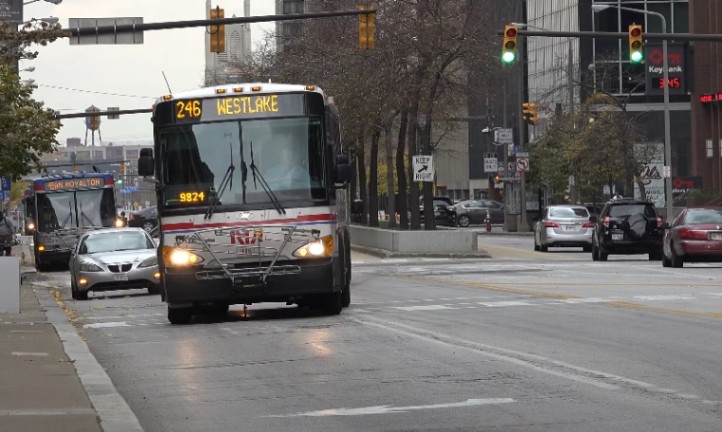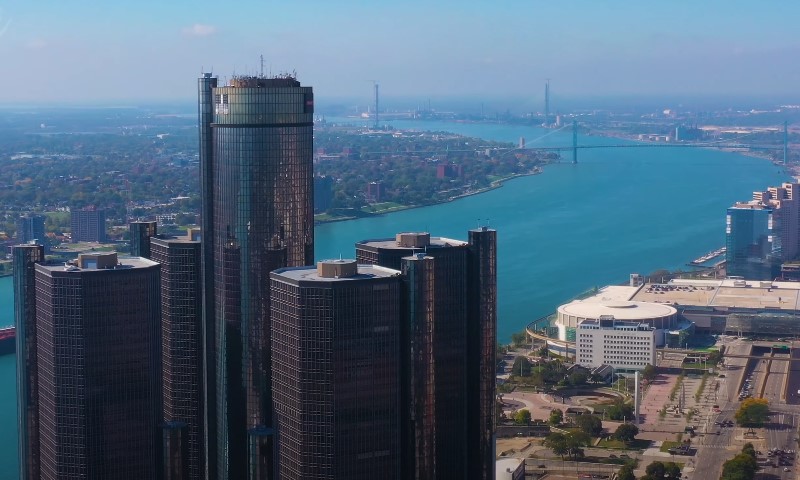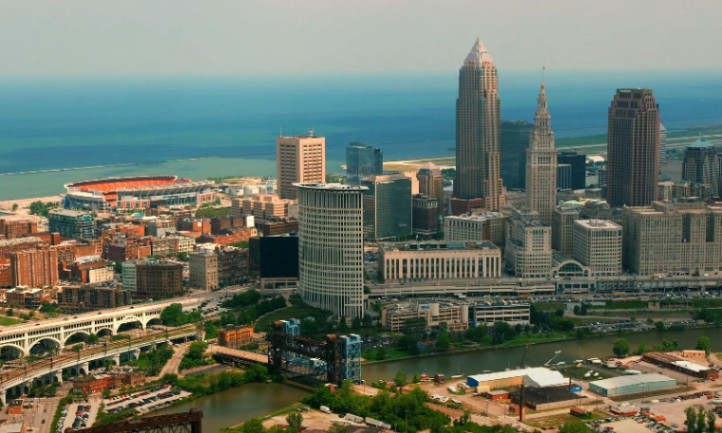Moving around the Great Lakes often means weighing two names with weighty history, bold character, and loyal residents: Cleveland and Detroit.
Both stand as symbols of American industry and resilience. Yet they live differently when you look at how people work, spend, raise families, and relax.
We prepared a comparison based on current data in 2025, drawn from federal and city sources. If you’re thinking of relocating, it’ll help you see which one fits the life you actually want.
A Quick Look
| Category | Cleveland | Detroit |
| Typical Home Value (Zillow 2025) | ~$113,000 | ~$79,000 |
| Metro GDP (2023) | ~$173B | ~$331B |
| Unemployment (Late 2024) | ~3.9% | ~4.5% |
| 2024 Homicides | 105 | 203 |
| Top Hospital System | Cleveland Clinic (Global-tier) | Henry Ford Health (Regional-tier) |
| State Income Tax | Graduated (Ohio) | Flat (Michigan) |
| City Income Tax | CCA-administered | 2.4% resident rate |
| Annual Snowfall (Approx.) | ~60+ inches | ~41 inches |
| Major Parks or Waterfront Highlights | Cleveland Metroparks “Emerald Necklace” | Detroit Riverwalk |
| Major Employers | Cleveland Clinic, Progressive, Sherwin-Williams | GM, Ford, Stellantis, Quicken Loans |
Cost of Living and Housing
Living costs often decide whether a city feels comfortable or stressful. In Cleveland and Detroit, housing prices and daily expenses stay remarkably within reach for most budgets.
Home Values and Affordability
Affordability is where both cities shine. According to Zillow , the median home value in Detroit sits near $79,000 , one of the lowest among major U.S. cities. Cleveland averages about $113,000 , which is still remarkably affordable compared with the national median of roughly $364,000 .
Both markets let first-time buyers enter ownership faster than nearly anywhere on the coasts. Investors find short breakeven periods and potential cash flow in select neighborhoods.
Cleveland’s real estate has been moving a bit faster recently, with homes often selling close to list price and sometimes within daysm, it all depends on the area. Detroit’s market remains highly segmented: five-figure properties in revitalizing neighborhoods coexist with homes well above $200,000 in others.
Rent and Monthly Costs
Median rents across both cities remain well below U.S. averages. According to the latest American Community Survey , typical rents hover around the low-to-mid $900s per month in both metros.
- Cleveland: Some inner neighborhoods are pushing above $1,100, but outer suburbs remain in the $800s range. Apartments reports that the average monthly rent in 2025 is around $1300.
- Detroit: Midtown, Corktown, and certain Downtown districts approach $1,200+, while many single-family rentals in peripheral neighborhoods stay under $900. According to Apartments , the average monthly rent is around $1.100.
For groceries, utilities, and everyday costs, both cities land roughly 15–20% below the national average , according to the Council for Community and Economic Research.
Takeaway on Cost
Detroit wins on the entry-level home price. Cleveland delivers slightly faster liquidity and resale stability. In either case, your housing budget stretches far more than it would in most large metros.
Jobs, Income, and Local Economies
View this post on Instagram
Work defines a city’s rhythm. In both Cleveland and Detroit, jobs mirror their industrial DNA: autos, health care, logistics, and skilled trades keep each metro running.
The mix of pay, stability, and opportunity tells you what daily life might feel like once you’re settled.
Economic Scale
According to FRED , Detroit’s metro economy towers in size, reaching roughly $331 billion in 2023 GDP , nearly double Cleveland’s $173 billion .
That scale creates more industry clusters, especially automotive, engineering, logistics, and parts manufacturing.
Cleveland’s economy, while smaller, has strong anchors in health care, polymers, insurance, and headquarters services . Those sectors help cushion employment swings tied to manufacturing cycles.
Labor Market and Unemployment

By late 2024, the Detroit metro unemployment rate hovered near 4.5% , while Cleveland’s sat around 3.9% . The pattern tends to repeat: Detroit shows bigger ups and downs tied to auto demand, while Cleveland stays steadier.
Typical Household Incomes
- Detroit Metro: Roughly $72,574 median household income (per Census Reporter ).
- Cleveland Metro: Around $67,586 (per Census Reporter ).
- U.S. Average: About $80,610 (per Census Bureau ).
Pay varies sharply by industry. Automotive engineering, logistics management, and advanced manufacturing roles in Detroit can hit six figures.
Cleveland’s upper tiers are found in medical, legal, and corporate roles connected to the health and financial sectors.
Industry Pillars
Detroit:
- Automakers: Ford, General Motors, Stellantis.
- Tier suppliers: Magna, Lear, American Axle.
- Expanding tech-manufacturing hybrids and logistics centers near the airport and Windsor border.
Cleveland:
- Cleveland Clinic, University Hospitals, MetroHealth.
- Polymer science, coatings, and materials giants like Sherwin-Williams and Lubrizol.
- Insurance and financial operations centers.
Cleveland Clinic’s Regional Power
The Cleveland Clinic is a job engine of enormous scale. Including ripple effects, it supports more than 140,000 jobs statewide and contributes about $37.6 billion in national economic output, according to the statistics . That stabilizes Cleveland’s labor market even when other sectors slow.
Verdict on Jobs
If your path runs through automotive or supply-chain engineering, Detroit remains the heavyweight. For health care, research, or white-collar professional work, Cleveland holds the edge. Both offer solid blue-collar and trades demand, but their cycles differ.
Safety and Crime Trends

Crime numbers tell part of the story, but the pace of change matters more. Both Cleveland and Detroit have seen real progress lately, with violent crime dropping and community programs gaining traction.
Detroit’s Progress
In 2024, Detroit recorded 203 homicides , the fewest since 1965 , as per the City of Detroit . Shootings and carjackings also dropped by double digits. As of the third quarter of 2025, reports show that trend continuing downward.
Police and community programs focusing on neighborhood stabilization, lighted corridors, and targeted patrols have been credited with much of the improvement.
Cleveland’s Turnaround
Ideastream reported that Cleveland closed 2024 with 105 homicides , a sharp decline from its pandemic-era peaks.
The city credited coordinated summer initiatives, additional patrols, and expanded violence prevention programs for the progress.
National Perspective
The FBI’s national data shows violent crime fell nearly 12% in 2023 , and both cities followed that same positive curve.
Safety, however, is deeply local. In both places, some neighborhoods feel peaceful while others remain tense. Due diligence, talking to residents, and checking city crime maps, remains essential.
Summary
Both metros are getting safer year over year. Detroit’s drop from historic highs is notable. Cleveland’s improvement stands out for consistency. The work isn’t done, but directionally both are gaining ground.
Health Care and Medical Access
Health care can shape where you live more than almost any other factor. Both Cleveland and Detroit offer strong hospital networks, but the level of care and specialty access vary in ways worth knowing before you choose.
Cleveland’s Global Reputation
The Cleveland Clinic continues to rank among the best hospitals in the world. Its cardiology and heart surgery programs often hold the No. 1 spot nationally according to U.S. News & World Report .
The cluster of University Hospitals and MetroHealth adds depth, forming a world-class ecosystem for complex cases and medical research.
Detroit’s Health Network
Detroit’s Henry Ford Health and the Detroit Medical Center provide full-spectrum care, with satellite hospitals and outpatient centers throughout the metro.
Henry Ford Health’s partnerships with Michigan State University continue to expand clinical research capacity.
Also, the hospital was recognized as a “Best Regional Hospital for Equitable Access” by U.S. News .
Comparison Snapshot
| Metric | Cleveland | Detroit |
| Top Hospital Ranking (U.S. News 2024) | Cleveland Clinic #2 nationally | Henry Ford #27 nationally |
| Regional Hospital Network Size | ~15 hospitals, 220+ outpatient sites | ~30 hospitals regionwide (multi-system) |
| Specialty Strengths | Cardiology, Neurosurgery, Cancer | Orthopedics, Trauma, Primary Care Access |
Bottom Line on Health Care
Cleveland dominates when it comes to elite specialty care. Detroit performs strongly for broad access across a large metro. For anyone with major health conditions, Cleveland’s ecosystem remains a deciding factor.
Taxes and After-Tax Pay
Both states levy income tax, and both cities tack on their own municipal rates.
City-Level Taxes
According to the Michigan Department of Treasury :
- Detroit: 2.4% for residents, 1.2% for nonresidents who work in the city.
- Cleveland: Similar system under the Central Collection Agency (CCA) . The rate depends on your home and work city.
State-Level Taxes
- Michigan: Flat rate currently around 4.25% .
- Ohio: Graduated, topping out near 3.5% .
When comparing two job offers, model the combined impact of state and city taxes. Working in one city but living in another can shift your take-home pay by several hundred dollars per month.
Transportation and Everyday Mobility

Getting around Cleveland and Detroit shapes daily life more than many expect. Commute times, transit reach, and car reliance define how each city moves.
Commuting and Transit
Both metros rely heavily on cars. Average commute times are short by U.S. standards, around 24 minutes in Cleveland and 26 minutes in Detroit.
Transit Options
- Cleveland RTA: Rail and bus network serving key job corridors, including a rail line to the airport.
- Detroit DDOT and SMART: Improved coordination and newer routes across city and suburbs.
Air and Regional Travel
Both cities maintain competitive air service.
- Cleveland Hopkins International Airport and Detroit Metro Airport (DTW) provide broad coverage, with Detroit acting as a Delta hub and offering direct international connections.
- Amtrak connects each city to Chicago and the East Coast. Detroit’s cross-border proximity to Windsor adds another layer of international reach.
Climate and Air Quality

Winter hits hard across the Great Lakes, and both cities know it well. From lake-effect snow to summer ozone days, weather and air play a real role in how life feels year-round.
Snow and Seasons
Both cities face harsh winters, but Cleveland often takes the bigger hit. According to the National Weather Service :
| Category | Cleveland | Detroit |
| Average Annual Snowfall | ~60+ inches | ~41 inches |
| Average January High | 34°F | 33°F |
| Average July High | 82°F | 83°F |
Cleveland’s lake effect can double totals in certain years, particularly on the city’s east side. Detroit’s winter storms tend to be shorter but colder.
Air Quality
The American Lung Association’s State of the Air 2025 report shows both metros continuing gradual improvement. Summer ozone remains a challenge during heat waves, while winter inversions can elevate particulate levels.
Neither ranks among the nation’s worst, but monitoring local air alerts is still smart during extreme weather.
Parks, Water, and Weekend Life

Weekends in both cities feel grounded in green space and waterfront rhythm. From river paths to park trails, each city gives residents plenty of room to breathe, bike, and unwind outdoors.
Cleveland’s “Emerald Necklace”
The Cleveland Metroparks system is a standout. It circles the metro with over 24,000 acres of forest, trails, beaches, and golf courses.
It consistently wins national awards, including the National Gold Medal for Excellence in park management. Living in almost any suburb puts you near a trailhead.
Detroit’s Riverwalk and Greenways
Detroit’s Riverwalk keeps earning praise, named “Best Riverwalk in America” multiple times by USA Today . It ties together parks, plazas, and bike paths along the Detroit River, stretching toward Belle Isle.
The Dequindre Cut and expanding Joe Louis Greenway make urban cycling practical and fun.
Culture and Sports
Cleveland:
- Rock & Roll Hall of Fame
- Playhouse Square theater district
- Cleveland Museum of Art
- Guardians (MLB), Browns (NFL), Cavaliers (NBA)
Detroit:
- Detroit Institute of Arts
- Motown Museum
- Fox Theatre
- Tigers (MLB), Lions (NFL), Pistons (NBA), Red Wings (NHL)
Both calendars stay packed year-round with festivals, concerts, and game nights. The choice depends on your favorite venues and sports loyalties.
Population and Neighborhood Dynamics
Population trends tell a lot about how a city feels day to day. Both Cleveland and Detroit have seen long-term change, but recent data hints at steadier footing and new life in select neighborhoods.
City Populations
The Census Bureau’s 2024 estimates show both cities holding steady after decades of decline. Detroit’s population remains around 635,000 , while Cleveland’s stands near 360,000 .
Growth is happening in specific neighborhoods: Downtown, Midtown, and Corktown in Detroit; Ohio City, Tremont, and University Circle in Cleveland.
Migration and Reinvestment
Cuyahoga County’s slight population growth reflects international arrivals and young professionals returning post-pandemic.
Neighborhood change is hyper-local. Always walk the blocks, talk to residents, and visit at different times of day before you sign.
Who Should Pick Cleveland?

- Professionals in health care, medical research, or insurance .
- Anyone who values access to a world-class hospital system.
- Families looking for steady employment trends and extensive parkland.
- Residents who enjoy four distinct seasons and a strong arts-and-theater scene.
Cleveland offers a more stable labor profile, top-tier health care, and quick access to greenspace nearly anywhere you live.
Who Should Pick Detroit?
- Workers in automotive design, manufacturing, or logistics .
- Buyers seeking the lowest home prices among large U.S. cities.
- Entrepreneurs or small-scale developers drawn to revitalization opportunities.
- Residents who want to live near the Detroit Riverwalk , bike trails, and urban festivals.
Detroit remains a powerhouse for engineering and industry. The pace of change in some neighborhoods is fast, and the pride of place runs deep.
A Quick Tie-Breaker Checklist
| Factor | Pick Cleveland if… | Pick Detroit if… |
| Career Field | You work in health care, education, or research | You’re in autos, parts, or logistics |
| Housing Priority | You want resale stability and short listing times | You want the lowest purchase price |
| Commute Style | You prefer manageable drives with some transit backup | You’re fine being fully car-dependent |
| Tax Impact | You favor graduated state tax rates | You prefer a flat state rate |
| Outdoor Life | You want park trails everywhere | You love waterfront paths and bike routes |
| Medical Needs | You value world-class specialty care | You need strong general access and multiple options |
Bottom Line
You can live well in either city without breaking your budget. Both offer homes far below national prices, manageable commutes, and a sense of community that’s hard to find elsewhere.
Detroit stands taller economically, driven by its automotive base and rapid improvement in safety. Cleveland shines with health care leadership, steady job conditions, and an award-winning park network.
If your life or career centers around medicine, research, or a balanced local economy, Cleveland is likely your match. If you’re drawn to industrial energy, hands-on opportunity, and a dynamic housing market, Detroit delivers.
Whichever you pick, neighborhood choice will matter more than the name on your mailing address. Both cities reward those who invest time, respect, and curiosity in the communities they call home.

